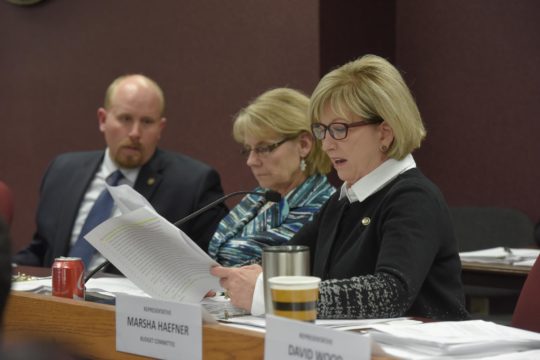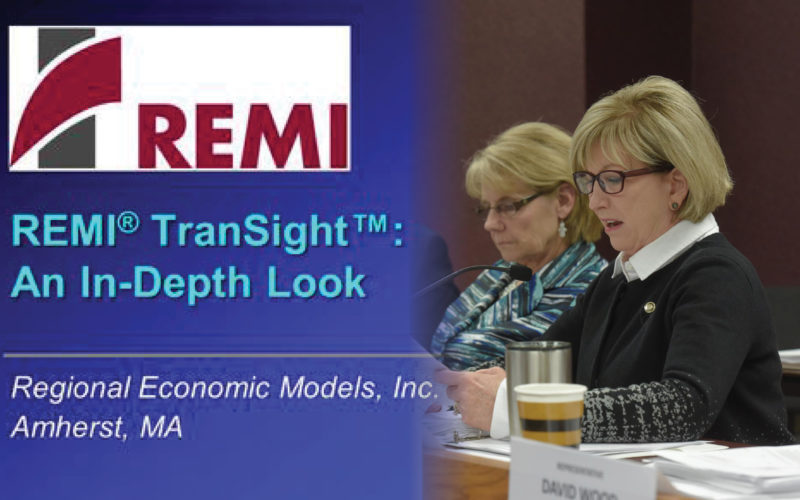JEFFERSON CITY, Mo. – Rep. Marsha Haefner, chairman of the House Fiscal Oversight Committee, plans to question state government bureaucracy over hundreds of thousands of taxpayer dollars in payments to a Massachusetts company, Regional Economic Models Incorporated (REMI).
REMI, an east coast corporation out of Massachusetts has ties to extremist environmentalist groups, the Barack Obama for President campaign, and several left-wing academics. It has consistently been criticized for skewing their REMI modeling away from valuing public investments in rural areas and toward encouraging projects with a goal of “social justice” in urban areas.
“We are experiencing extremely tight budgetary conditions and must scrutinize every expenditure in state government,” Haefner, R-St. Louis, said. “But even if we weren’t, I have serious questions about the hundreds of thousands of Missourians’ hard-earned tax dollars being shipped to the east coast to a corporation with very sketchy ties and even more questionable results.”
To understand how this out-of-state corporation has been able to take so many Missouri tax dollars back to Massachusetts, you have to look back to how and why the deal was cut with REMI first.

How REMI spread to Missouri
Under Governor Mel Carnahan, social spending skyrocketed with Medicaid expansion programs such as the State Children’s Health Insurance Program, and continued after the 2008 recession. When government revenues began to shrink, many within the bureaucracy were looking for ways to justify cutting spending in rural areas while maintaining the large outlays in urban areas.
It was during the Holden administration that the state began to move from traditional Missouri economic models that typically balanced spending between urban and rural areas and began utilizing the REMI modeling. The model consistently suggested that economic development dollars be moved away from projects like the Vine Street Apartments in downtown Poplar Bluff, Mo. and give data to justify skewing those dollars toward urban developments similar to the Pruitt-Igoe development in downtown St. Louis.

Each year, the Department of Economic Development’s (DED) budget requests for spending on the REMI model increased, and year after year, lawmakers not only became familiar with the REMI modeling, but some actually began to give their Massachusetts numbers more credibility than Missouri modeling numbers.
The term “REMI model” has become so ingrained into the Missouri economic development lexicon that many legislators who are not on the Budget Committee believe that it is a legitimate economic model, not a private corporation that the state pays hundreds of thousands of dollars to each year.
“I have heard the term REMI model so many times and been told that it is the only model out there for so long that I just began using it as fact. I have asked for other numbers or other approaches to evaluate programs, but the only thing you really get out of DED is REMI,” Rep. Rory Rowland, D-Independence, said.
“I question everything, every single line item in the budget, but when the only modeling you get is REMI modeling year after year, you eventually just have to accept the only numbers that are made available as credible,” Rep. Haefner added. “Even, when in cases like this one, we probably shouldn’t have.”
Regional Economic Modeling Incorporated’s left-wing ties
For a state whose voters have been moving state government to the right every election cycle, while also installing more and more rural Missouri lawmakers in legislative leadership every session, it seems puzzling that they would continue to spend hundreds of thousands of dollars a year on a left-wing company east coast company in REMI that by its very design skews development away from rural areas.
REMI was founded by University of Massachusetts-Amherst Professor George Treyz who performed similar economic analysis performed at all major universities, including the University of Missouri-Columbia.
However, what set his REMI model apart was its predictable results. Treyz’s model could offer near certainty in producing results that would predictably suggest public investment in urban areas and predictably downplay the positive results of investment in rural areas.
Furthermore, as Treyz’s company grew outside of the urban Massachusetts enclave, it was criticized for producing favorable results to fit the ideological nature of the politician leading the government that was paying them for their services.
And it was very clear which politicians shared the worldview of Treyz. Dating back to when the Federal Elections Commission began keeping electronic records, here is a list of the politicians financially supported by Professor Treyz:
- John Kerry for President
- Al Franken for Senate
- Harold Ford Jr. for Congress,
- Democratic Senatorial Campaign Committee
- Darcy Burner for Congress
- Democratic Congressional Campaign Committee
- Zack Space for Congress
- Committee to Elect Chris Murphy
- Jim Carney for Congress
- Paul Hodges for Congress
- Joe Sestak for Congress
- Joe Donnelly for Congress
- Harry Mitchell for Congress
- Friends of Mark Warner
- Obama Victory Fund Super PAC
- Udall for Senate in New Mexico
- Jim Driehaus for Congress
- Jeff Merkley for Senate
- Bruce Lunsford for Congress
- Jim Musgrove for Senate
- Udall for Senate in Colorado
- Jim Markey for Congress
- Martin Heinrich for Congress
In addition to these contributions, Professor Treyz was a longtime regular contributor to the Democratic National Committee and other left-wing causes. The REMI founder also made over half a dozen contributions to Barack Obama’s presidential campaign, Obama ultimately would go on to be called a socialist by many leading members of the Missouri General Assembly. In addition to Obama, Treyz was also a contributor to Sen. Claire McCaskill’s U.S. Senate campaign.
But, REMI’s Chris Judson says the models are not biased.
“In short, REMI models are unbiased, it is not left or right leaning,” Judson said in an email to the Missouri Times. “Our modeling platform has over 35 years of research, utilizes publicly available data and has been cited in several academic journals.”
When asked for a reaction after being presented the list of dozens of Democratic politicians that the founder of the REMI model supported, Sen. Gary Romine, R- Ste. Genevieve, asked the obvious question: “It seems questionable that their founder contributed to dozens of Democrats, but never saw fit to support any Republican running for any federal office in any year.”
However, what might be the most troubling to current leaders in the General Assembly is the connections to radical environmentalist groups. The left-wing group Citizens Climate Lobby paid REMI to do a study on a massive carbon tax the group is currently lobbying Congress to pass.
The carbon tax would seek to impose massive taxes CO2 emissions on nearly everything a human being could come into contact with. Most analysts, and nearly 100 percent of conservative analysts, have projected that a carbon tax similar to the one being promoted by the left-wing group would be the biggest tax increase not only in American history, but the history of western civilization.
However, after being hired by the far left Citizen’s Climate Lobby, the REMI model seemingly provided the results the environmentalists were seeking. The REMI model actually projects that a carbon tax increase would result in 2.8 million new jobs and “a bolstered economy.”
When asked his thoughts on a carbon tax, Sen. Doug Libla, R-Poplar Bluff, commented, “A carbon tax will never come to a vote in the Missouri Senate, ever. I’m serious, never.”
When explained that the same REMI model that the Department of Economic Development uses to assess value on public projects is the same REMI model that says a carbon tax would actually be good for the American economy, the former factory owner replied, “If that is true, there are some people that have some explaining to do next session, and maybe before.”
After Professor Treyz’s retirement, his Ivy League-educated son Frederick Treyz assumed the leadership at REMI corporation. However, even with the change in leadership, the liberal political leanings of REMI’s chief executive did not. He continued REMI’s tradition of making several contributions to the Democratic National Committee and Barack Obama. In fact, he was such a devoted supporter of Obama that he was invited to join other Obama devotees at the 2008 Democratic National Convention.
Those most ardent of Obama supporters who traveled to Denver would cheer a speech that included lines such as, “For over two decades, [Romney] subscribed to that old, discredited Republican philosophy — give more and more to those with the most and hope that prosperity trickles down to everyone else. In Washington, they call this the Ownership Society, but what it really means is — you’re on your own. Out of work? Tough luck. No health care? The market will fix it. Born into poverty? Pull yourself up by your own bootstraps — even if you don’t have boots. You’re on your own. Well, it’s time for them to own their failure. It’s time for us to change America. You see, we Democrats have a very different measure of what constitutes progress in this country.”
Not only is Treyz a big Obama supporter, but the No. 2 executive at REMI, Sherri Lawrence, has also made several contributions to Barack Obama’s campaigns. There are other members of the leadership team at REMI who have made contributions to other Democrats, from Hillary Clinton’s 2016 presidential campaign to various Democratic congressional candidates.
However, after Sen. Romine’s prior observation we did some research and found that no member of the REMI staff listed on their website has ever made a recorded contribution to any Republican running for any federal office in any election year.
Missouri Alternatives
With the clear flaws and biases in the REMI model, some legislators have begun looking for alternatives.
“Just as we need news free of liberal bias, we have to have data free of liberal bias to help guide our policy-making, and hopefully several sources of data to compare and contrast,” Rep. Haefner said. “As a businesswoman, I like competing data services and time will tell which ones are superior.”
There have been several commissions established to study tax policy, in fact, there has been a commission established by every governor this millennium, including the most recent governor who made pledges to “do different.” Last decade, a new Missouri model was established by those who were becoming skeptical of the liberal and urban biases of REMI.
The Missouri BKD model established with help from Missouri State University in Springfield, Mo. took in all types of data points to give a more fair and balanced view of the value of Missouri’s economic development programs.
To the surprise of no one, when a Missouri model was done by Missourians at Missouri State University in Springfield, it showed far different results on Missouri public policy than the studies done on the Show-Me State by Massachusettsans at University of Massachusetts.
In defense of REMI
While the REMI model has come under fire, it still has several defenders, especially from Democratic and urban legislators. A leader of the Ferguson protests turned State Representative Bruce Franks, D-St. Louis City, stepped forward most forcefully, saying:

“We have to have systems in place to implement social justice,” Rep. Franks said. “A model that helps bring as much investment as possible into programs like Medicaid expansion and summer work and training programs, like I have introduced, is important to keep in place to guide our decisions in the General Assembly. I see no issue with the state using companies like REMI who understand and support our social justice agenda.”
REMI CEO and Chief Economist Frederick Treyz also defended the model, saying it does not have bias and is also used by right-leaning groups.
“The REMI model is based on peer-reviewed research modeling the way regional economies work (include the Missouri economy),” Treyz emailed the Missouri Times. “It does not represent any political bias, and reflects the empirical evidence regarding the economy.

The Missouri Times has spoken to many past and current employees inside the DED, some of whom had positive things to say about the REMI model. Most knew it as the only set of data they had consistently available, so it was just assumed to be correct.
However, one former DED employee in the Nixon administration spoke to the Missouri Times on the condition of anonymity.
“We were thrilled when the BKD model surfaced, at least it was a comparative tool. There are several models, most of them were much less expensive than the REMI model. The University of Missouri would probably do these same studies that REMI does for little to nothing. We are always encouraged to highlight the costs of any tax credit development, and we knew that we were to bury any data that showed them as valuable and we told that to our sales rep or consultant with REMI. Before that, REMI would show about two of every three tax credit projects as bad investments, usually ones in rural Missouri. After we told them we were turning against tax credit programs around the start of Governor Nixon’s second term, every REMI model slammed every tax credit development right on cue. That’s when I had my ‘ah ha’ moment with them.”
While there are questions, the longevity of the program has won it supporters.
How the REMI model influences public policy
The REMI models are used throughout Missouri government to assess public investments, but perhaps nowhere more than at the Missouri Housing Development Finance Commission, where they score each project.
MHDC administers tax credit programs, a great deal of which are done in rural Missouri, and the REMI model is often cited by urban politicians and urban newspapers to attack the developments.
Also in the last four Governor’s commissions on taxes, the REMI model was routinely cited as fact in assessing development projects. The latest commission, which was widely mocked and maligned as a forgone conclusion, was aimed at proposing legislation to be taken up by the General Assembly.
In a report that was largely diluted down by political concerns to essentially a rewrite of Governor Nixon’s commission report, in between quoting authorities well respected by the General Assembly, such as former St. Louis Post-Dispatch statehouse reporter Virginia Young, there were more than three dozen references to the REMI model or studies in which the REMI model was used in the formation of the study.
Earlier this year, State Auditor Nicole Galloway’s office essentially rewrote a former audit conducted under Auditor Tom Schweich, where they were highly critical of economic development programs in which the investment in rural Missouri was considerable.
In the rewrite, the Auditor’s Office perhaps knew of the growing discontent and skepticism of the REMI model and went to considerable lengths not to directly cite the company. Instead, references were made to reports and forms in which the REMI information was used.
There were several long-time DED employees who were very high on the REMI model and the people they worked with at REMI. A few even mentioned how much they enjoyed the conferences that REMI puts on. According to DED, employees attended REMI training in FY2015 and FY2016.
REMI held their most recent conference in Charleston, SC last month. There are several topics touched on, as well as several networking sessions similar to most any conference.
However, the lineup of speakers sported the liberal and urban trend. Apart from having Ted Egan, an economist with the City of San Francisco, keynoting a session, also invited to speak was:
- Carmen Liron-Espana, a longtime Democratic donor
- Claudette Robey, who has written for the liberal Brookings Institute think tank
- George Erickcek, a donor to ActBlue, which bills itself as “a nonprofit, building fundraising technology for the left”
- Jennifer Budoff, frequent Democratic donor, including a contributor to Barack Obama
- Susanna Groves, who made seven contributions to Hillary Clinton’s presidential campaign.
Again, we asked Sen. Romine’s question and searched for any sign of fairness and balance in the conference, and again we found that there were no speakers listed on the program who had ever given a recorded contribution to any Republican for any federal office in any election.
What is next for the state’s relationship with Regional Economic Modeling Incorporated?
During our research, we received several questions and hypotheses from legislators as to why the Greitens administration didn’t immediately sever the relationship with REMI upon taking office.
The first, Missouri’s budget year ends in June. Missouri has only been operating under Gov. Greitens budget for approximately 10 weeks. Further, the lengthy delay in filling the Greitens cabinet meant that new DED director Rob Dixon had only been on the job days before his department’s budget was completed.
Others have suggested, as is the case with every vendor in the state, that REMI made a large contribution to the dark money group “A New Missouri” which has direct ties to the Governor and operates its shady operation just a block south of the Governor’s Mansion in Jefferson City.
Whatever the reason for a presumably conservative governor maintaining a relationship with a left-wing organization such as REMI, it appears it is about to come under more scrutiny than ever before, as Chairwoman Haefner is considering hearings on the state’s large appropriation to REMI.
“All of these things are very troubling, and now more than ever we have to pinch every penny so hearings may be the appropriate next step,” Haefner said.
Rachael Herndon was the editor at The Missouri Times and also produced This Week in Missouri Politics, published Missouri Times Magazine, and co-hosted the #MoLeg podcast. She joined The Missouri Times in 2014, returning to political reporting after working as a campaign and legislative staffer.
Rachael studied at the University of Missouri – Columbia. She lives in Jefferson City with her husband, Brandon, and their two children.














